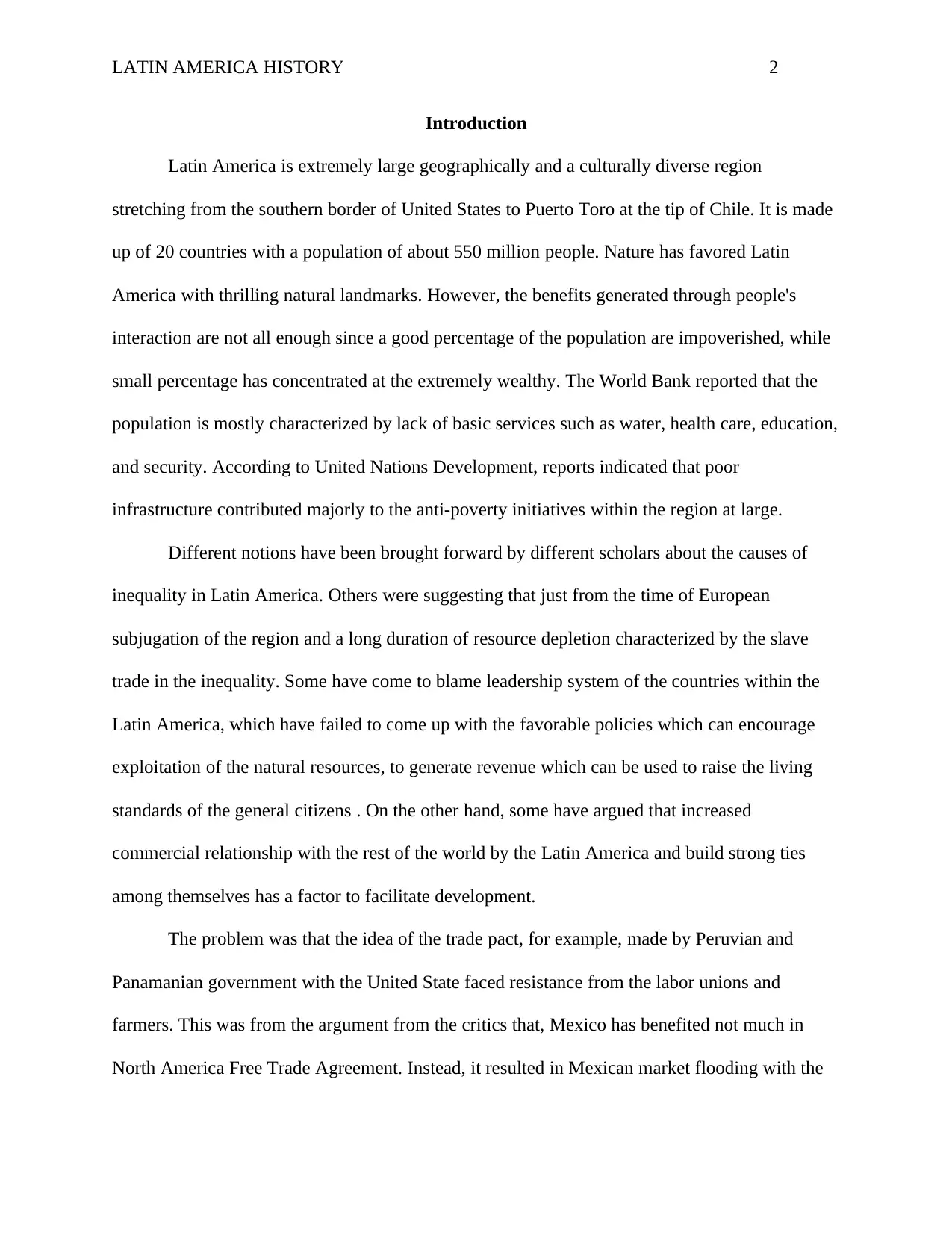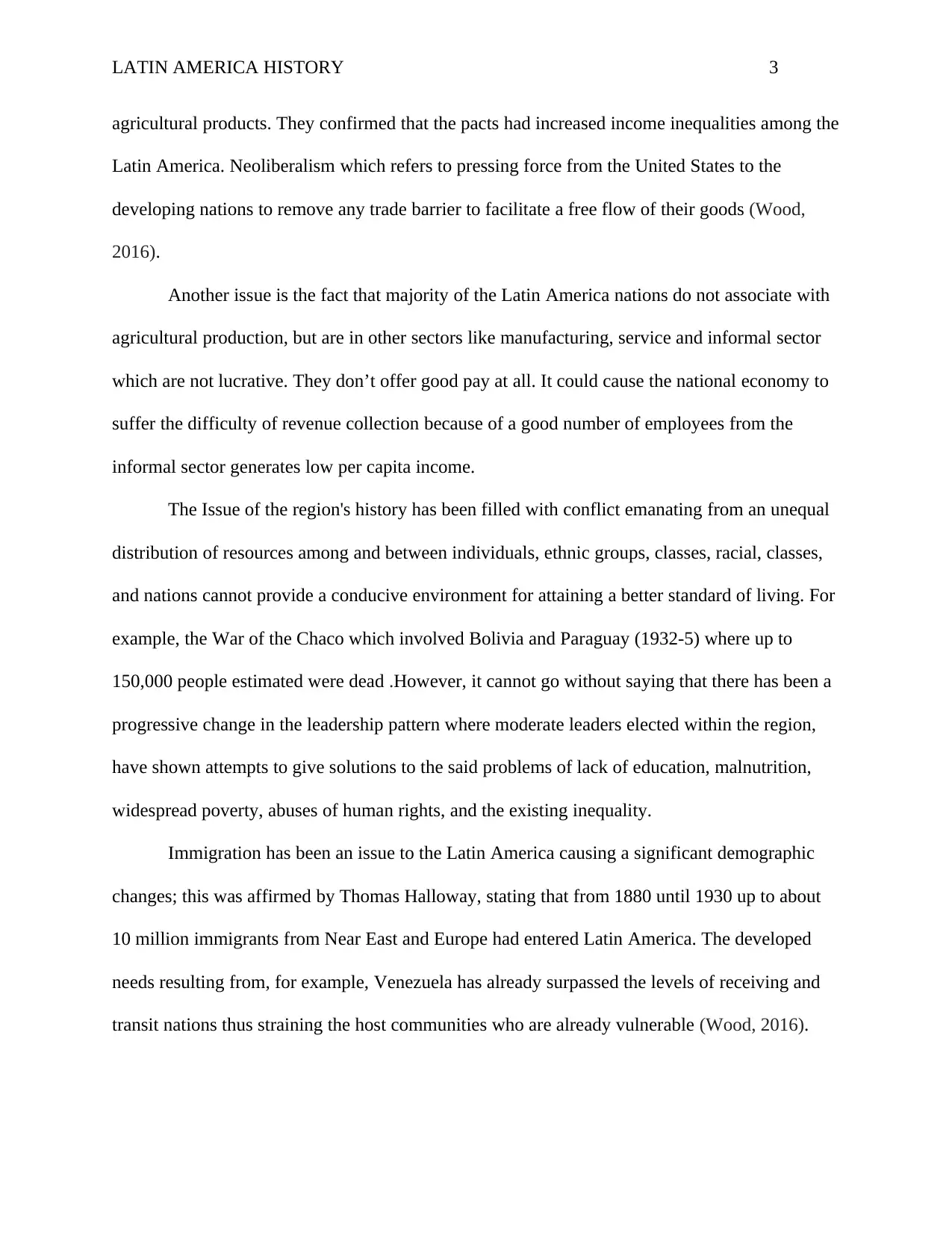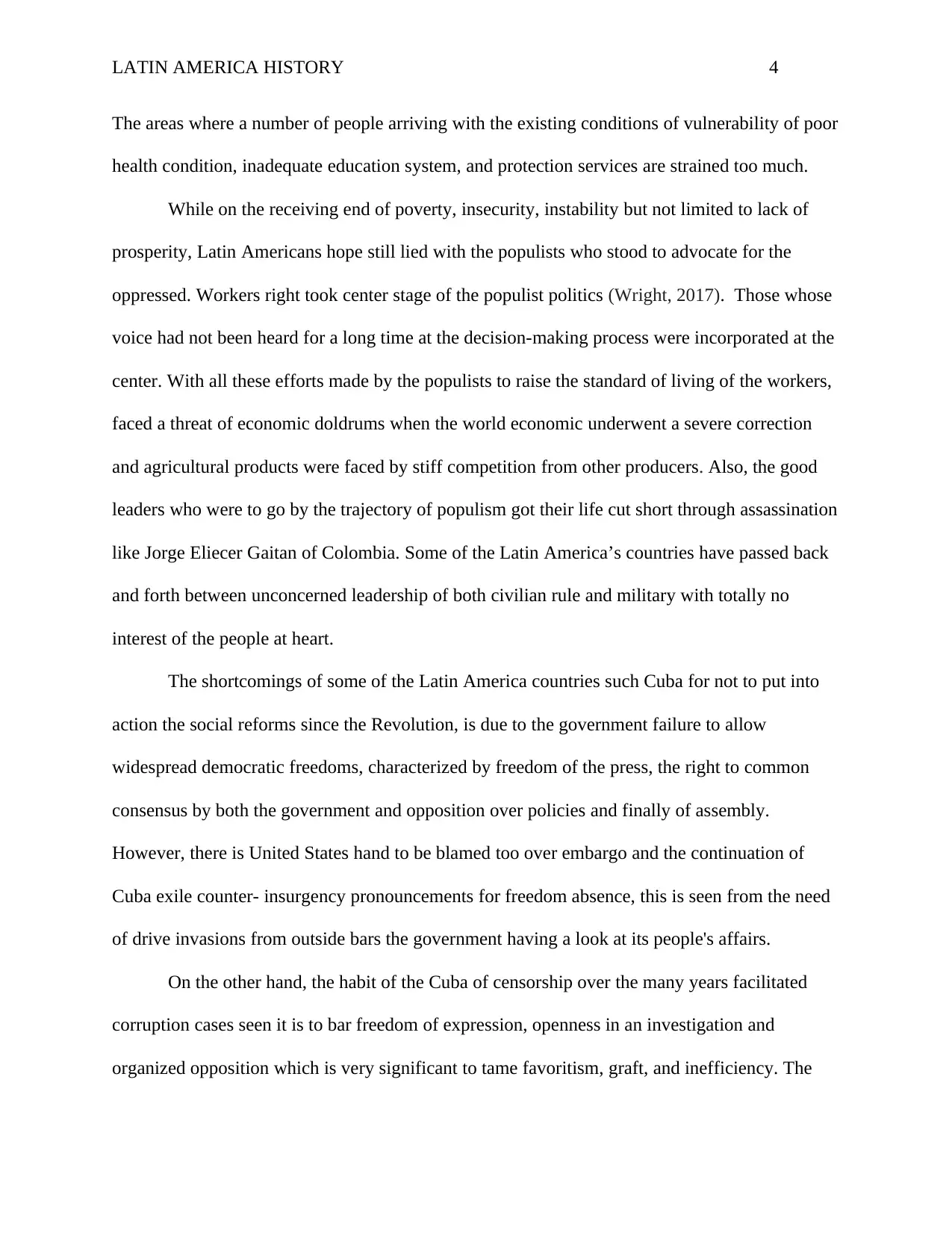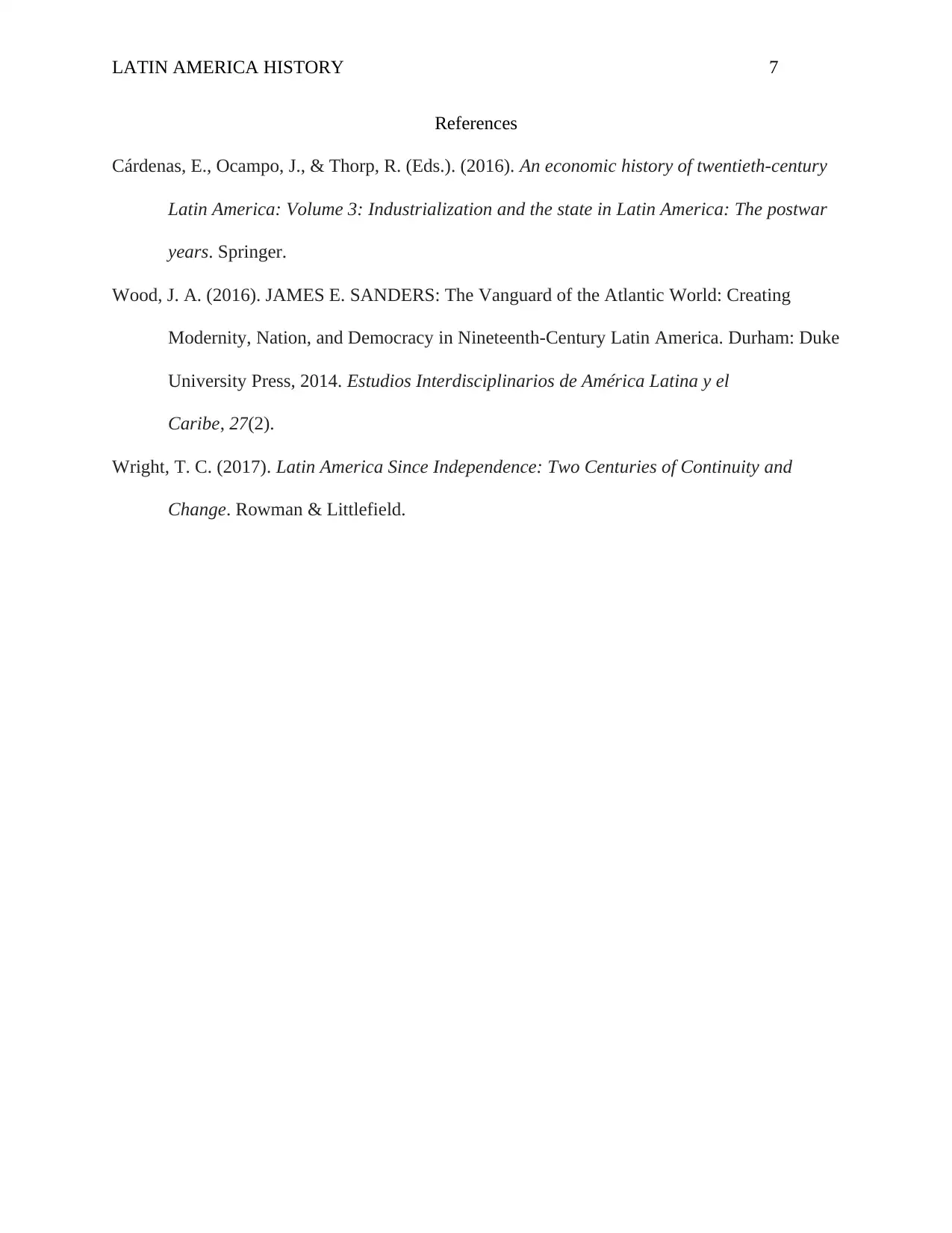Analyzing Latin America History: Development, Conflict, and Challenges
VerifiedAdded on 2023/05/28
|7
|1842
|406
Essay
AI Summary
This essay provides an overview of Latin America's history, highlighting key issues such as inequality, immigration, and the impact of historical conflicts. It discusses the role of populism and the challenges faced by Latin American countries in achieving economic development and stability. The essay also addresses the influence of external factors, including the United States' policies and the effects of globalization, on the region. It examines the shortcomings of various leadership approaches, including civilian and military rule, and the impact of neoliberalism on socioeconomic inequalities. Furthermore, it touches on specific issues like water shortages due to poor infrastructure and the debate surrounding the war on cocaine. The essay concludes by emphasizing the ongoing efforts of some Latin American countries to embrace democracy and free trade in pursuit of improved living standards, and users can find similar essays and resources on Desklib.

LATIN AMERICA HISTORY 1
Latin America History
Student’s Name
Institution Affiliate
Date
Latin America History
Student’s Name
Institution Affiliate
Date
Paraphrase This Document
Need a fresh take? Get an instant paraphrase of this document with our AI Paraphraser

LATIN AMERICA HISTORY 2
Introduction
Latin America is extremely large geographically and a culturally diverse region
stretching from the southern border of United States to Puerto Toro at the tip of Chile. It is made
up of 20 countries with a population of about 550 million people. Nature has favored Latin
America with thrilling natural landmarks. However, the benefits generated through people's
interaction are not all enough since a good percentage of the population are impoverished, while
small percentage has concentrated at the extremely wealthy. The World Bank reported that the
population is mostly characterized by lack of basic services such as water, health care, education,
and security. According to United Nations Development, reports indicated that poor
infrastructure contributed majorly to the anti-poverty initiatives within the region at large.
Different notions have been brought forward by different scholars about the causes of
inequality in Latin America. Others were suggesting that just from the time of European
subjugation of the region and a long duration of resource depletion characterized by the slave
trade in the inequality. Some have come to blame leadership system of the countries within the
Latin America, which have failed to come up with the favorable policies which can encourage
exploitation of the natural resources, to generate revenue which can be used to raise the living
standards of the general citizens . On the other hand, some have argued that increased
commercial relationship with the rest of the world by the Latin America and build strong ties
among themselves has a factor to facilitate development.
The problem was that the idea of the trade pact, for example, made by Peruvian and
Panamanian government with the United State faced resistance from the labor unions and
farmers. This was from the argument from the critics that, Mexico has benefited not much in
North America Free Trade Agreement. Instead, it resulted in Mexican market flooding with the
Introduction
Latin America is extremely large geographically and a culturally diverse region
stretching from the southern border of United States to Puerto Toro at the tip of Chile. It is made
up of 20 countries with a population of about 550 million people. Nature has favored Latin
America with thrilling natural landmarks. However, the benefits generated through people's
interaction are not all enough since a good percentage of the population are impoverished, while
small percentage has concentrated at the extremely wealthy. The World Bank reported that the
population is mostly characterized by lack of basic services such as water, health care, education,
and security. According to United Nations Development, reports indicated that poor
infrastructure contributed majorly to the anti-poverty initiatives within the region at large.
Different notions have been brought forward by different scholars about the causes of
inequality in Latin America. Others were suggesting that just from the time of European
subjugation of the region and a long duration of resource depletion characterized by the slave
trade in the inequality. Some have come to blame leadership system of the countries within the
Latin America, which have failed to come up with the favorable policies which can encourage
exploitation of the natural resources, to generate revenue which can be used to raise the living
standards of the general citizens . On the other hand, some have argued that increased
commercial relationship with the rest of the world by the Latin America and build strong ties
among themselves has a factor to facilitate development.
The problem was that the idea of the trade pact, for example, made by Peruvian and
Panamanian government with the United State faced resistance from the labor unions and
farmers. This was from the argument from the critics that, Mexico has benefited not much in
North America Free Trade Agreement. Instead, it resulted in Mexican market flooding with the

LATIN AMERICA HISTORY 3
agricultural products. They confirmed that the pacts had increased income inequalities among the
Latin America. Neoliberalism which refers to pressing force from the United States to the
developing nations to remove any trade barrier to facilitate a free flow of their goods (Wood,
2016).
Another issue is the fact that majority of the Latin America nations do not associate with
agricultural production, but are in other sectors like manufacturing, service and informal sector
which are not lucrative. They don’t offer good pay at all. It could cause the national economy to
suffer the difficulty of revenue collection because of a good number of employees from the
informal sector generates low per capita income.
The Issue of the region's history has been filled with conflict emanating from an unequal
distribution of resources among and between individuals, ethnic groups, classes, racial, classes,
and nations cannot provide a conducive environment for attaining a better standard of living. For
example, the War of the Chaco which involved Bolivia and Paraguay (1932-5) where up to
150,000 people estimated were dead .However, it cannot go without saying that there has been a
progressive change in the leadership pattern where moderate leaders elected within the region,
have shown attempts to give solutions to the said problems of lack of education, malnutrition,
widespread poverty, abuses of human rights, and the existing inequality.
Immigration has been an issue to the Latin America causing a significant demographic
changes; this was affirmed by Thomas Halloway, stating that from 1880 until 1930 up to about
10 million immigrants from Near East and Europe had entered Latin America. The developed
needs resulting from, for example, Venezuela has already surpassed the levels of receiving and
transit nations thus straining the host communities who are already vulnerable (Wood, 2016).
agricultural products. They confirmed that the pacts had increased income inequalities among the
Latin America. Neoliberalism which refers to pressing force from the United States to the
developing nations to remove any trade barrier to facilitate a free flow of their goods (Wood,
2016).
Another issue is the fact that majority of the Latin America nations do not associate with
agricultural production, but are in other sectors like manufacturing, service and informal sector
which are not lucrative. They don’t offer good pay at all. It could cause the national economy to
suffer the difficulty of revenue collection because of a good number of employees from the
informal sector generates low per capita income.
The Issue of the region's history has been filled with conflict emanating from an unequal
distribution of resources among and between individuals, ethnic groups, classes, racial, classes,
and nations cannot provide a conducive environment for attaining a better standard of living. For
example, the War of the Chaco which involved Bolivia and Paraguay (1932-5) where up to
150,000 people estimated were dead .However, it cannot go without saying that there has been a
progressive change in the leadership pattern where moderate leaders elected within the region,
have shown attempts to give solutions to the said problems of lack of education, malnutrition,
widespread poverty, abuses of human rights, and the existing inequality.
Immigration has been an issue to the Latin America causing a significant demographic
changes; this was affirmed by Thomas Halloway, stating that from 1880 until 1930 up to about
10 million immigrants from Near East and Europe had entered Latin America. The developed
needs resulting from, for example, Venezuela has already surpassed the levels of receiving and
transit nations thus straining the host communities who are already vulnerable (Wood, 2016).
⊘ This is a preview!⊘
Do you want full access?
Subscribe today to unlock all pages.

Trusted by 1+ million students worldwide

LATIN AMERICA HISTORY 4
The areas where a number of people arriving with the existing conditions of vulnerability of poor
health condition, inadequate education system, and protection services are strained too much.
While on the receiving end of poverty, insecurity, instability but not limited to lack of
prosperity, Latin Americans hope still lied with the populists who stood to advocate for the
oppressed. Workers right took center stage of the populist politics (Wright, 2017). Those whose
voice had not been heard for a long time at the decision-making process were incorporated at the
center. With all these efforts made by the populists to raise the standard of living of the workers,
faced a threat of economic doldrums when the world economic underwent a severe correction
and agricultural products were faced by stiff competition from other producers. Also, the good
leaders who were to go by the trajectory of populism got their life cut short through assassination
like Jorge Eliecer Gaitan of Colombia. Some of the Latin America’s countries have passed back
and forth between unconcerned leadership of both civilian rule and military with totally no
interest of the people at heart.
The shortcomings of some of the Latin America countries such Cuba for not to put into
action the social reforms since the Revolution, is due to the government failure to allow
widespread democratic freedoms, characterized by freedom of the press, the right to common
consensus by both the government and opposition over policies and finally of assembly.
However, there is United States hand to be blamed too over embargo and the continuation of
Cuba exile counter- insurgency pronouncements for freedom absence, this is seen from the need
of drive invasions from outside bars the government having a look at its people's affairs.
On the other hand, the habit of the Cuba of censorship over the many years facilitated
corruption cases seen it is to bar freedom of expression, openness in an investigation and
organized opposition which is very significant to tame favoritism, graft, and inefficiency. The
The areas where a number of people arriving with the existing conditions of vulnerability of poor
health condition, inadequate education system, and protection services are strained too much.
While on the receiving end of poverty, insecurity, instability but not limited to lack of
prosperity, Latin Americans hope still lied with the populists who stood to advocate for the
oppressed. Workers right took center stage of the populist politics (Wright, 2017). Those whose
voice had not been heard for a long time at the decision-making process were incorporated at the
center. With all these efforts made by the populists to raise the standard of living of the workers,
faced a threat of economic doldrums when the world economic underwent a severe correction
and agricultural products were faced by stiff competition from other producers. Also, the good
leaders who were to go by the trajectory of populism got their life cut short through assassination
like Jorge Eliecer Gaitan of Colombia. Some of the Latin America’s countries have passed back
and forth between unconcerned leadership of both civilian rule and military with totally no
interest of the people at heart.
The shortcomings of some of the Latin America countries such Cuba for not to put into
action the social reforms since the Revolution, is due to the government failure to allow
widespread democratic freedoms, characterized by freedom of the press, the right to common
consensus by both the government and opposition over policies and finally of assembly.
However, there is United States hand to be blamed too over embargo and the continuation of
Cuba exile counter- insurgency pronouncements for freedom absence, this is seen from the need
of drive invasions from outside bars the government having a look at its people's affairs.
On the other hand, the habit of the Cuba of censorship over the many years facilitated
corruption cases seen it is to bar freedom of expression, openness in an investigation and
organized opposition which is very significant to tame favoritism, graft, and inefficiency. The
Paraphrase This Document
Need a fresh take? Get an instant paraphrase of this document with our AI Paraphraser

LATIN AMERICA HISTORY 5
United States has been so hostile towards some regime like for the Cuba government thus putting
it difficult for the relationship between them (Wood, 2016). Confirmed by the United States, they
have formed a very powerful enmity with Cuba so the enforcement of loyalty and compliance
with their party doctrines, for whatever the price to the intellectual, social and cultural life of the
citizens.
The Washington Consensus also had an issue to some of the Latin America countries like
in Mexico which had almost close tie with the United States as the economic decline in the
capital of finance sinks. Even though Mexico is politically stable, but due to lack of a reform-
oriented government makes it unable to achieve the living standards and security of the Western
(Wright, 2017). On the one hand, Chile's transition to democracy has embraced the move to be at
peace with neoliberalism and privatization than focusing at the danger of socioeconomic
inequalities. Privatization became difficult to dismantle by the state. Again while the state had
put all her efforts towards ending illiteracy level, poverty and malnutrition, the conservatives in
the Congress opposed the move. This became the tragedy in Chile.
The economy controlled by the foreign investment characterized by dormant public
works to address the needs of the poor evident by building of the superhighways for automobiles,
luxurious erections, and high rise apartments or rather building houses for the poor who are
desperate in the slum were full concerns to the rich (Wright, 2017). The Latin America nations
such a Peru and Bolivia with the most glacier base also experience water shortage very severely,
this is as a result of poor infrastructure like in Mexico where it is reported up to 90 percent of the
water loss due to leaky pipes, but this trend is evident in almost all the Latin America countries.
Privatization of the water sector is another reason why there is a water problem in the region.
United States has been so hostile towards some regime like for the Cuba government thus putting
it difficult for the relationship between them (Wood, 2016). Confirmed by the United States, they
have formed a very powerful enmity with Cuba so the enforcement of loyalty and compliance
with their party doctrines, for whatever the price to the intellectual, social and cultural life of the
citizens.
The Washington Consensus also had an issue to some of the Latin America countries like
in Mexico which had almost close tie with the United States as the economic decline in the
capital of finance sinks. Even though Mexico is politically stable, but due to lack of a reform-
oriented government makes it unable to achieve the living standards and security of the Western
(Wright, 2017). On the one hand, Chile's transition to democracy has embraced the move to be at
peace with neoliberalism and privatization than focusing at the danger of socioeconomic
inequalities. Privatization became difficult to dismantle by the state. Again while the state had
put all her efforts towards ending illiteracy level, poverty and malnutrition, the conservatives in
the Congress opposed the move. This became the tragedy in Chile.
The economy controlled by the foreign investment characterized by dormant public
works to address the needs of the poor evident by building of the superhighways for automobiles,
luxurious erections, and high rise apartments or rather building houses for the poor who are
desperate in the slum were full concerns to the rich (Wright, 2017). The Latin America nations
such a Peru and Bolivia with the most glacier base also experience water shortage very severely,
this is as a result of poor infrastructure like in Mexico where it is reported up to 90 percent of the
water loss due to leaky pipes, but this trend is evident in almost all the Latin America countries.
Privatization of the water sector is another reason why there is a water problem in the region.

LATIN AMERICA HISTORY 6
According to Wood (2016), most of the Latin American governments could not enjoy the
fruits of globalization due to many regulations characterized by manipulation of currency and
corruption. Besides the promises of freeing the region of the past burdens, Venezuela’s Hugo
Chavez puts the measures seen as a recipe for disaster. The success of the region greatly lies on
the further market reforms fairly implemented and honestly pursued. These were evident by the
Brazil side under the President Luis Inacio da Silva. Many countries within the Latin America
including Brazil, Peru, and Paraguay have struggled to reinvent by taking the course of
democracy and free trade. Through democracy of one government, after the other inflations have
been brought down and growth have been restored, wealth relatively started trickling down to the
poor.
The debate on the war on cocaine by the United States of whether to militarize it took
another dimension, as countries like Colombia, Peru, and Andes uses this means as a source of
raising revenue from the traffickers. It is also confirmed in Bolivia when the miners of Marxist
who had gone jobless by the time the tin business was sold by the government channeled the
money in organizing coca farmers (Cárdenas, Ocampo & Thorp, 2016). Gen. Augusto Pinochet
of Chile used tears gas, water cannon and mass arrests to quit his critics, in so doing he imposed
changes in structural economic which brought the effect of 40 percent decrease in real wages and
high rate of unemployment in the urban setting of Latin America.
According to Wood (2016), most of the Latin American governments could not enjoy the
fruits of globalization due to many regulations characterized by manipulation of currency and
corruption. Besides the promises of freeing the region of the past burdens, Venezuela’s Hugo
Chavez puts the measures seen as a recipe for disaster. The success of the region greatly lies on
the further market reforms fairly implemented and honestly pursued. These were evident by the
Brazil side under the President Luis Inacio da Silva. Many countries within the Latin America
including Brazil, Peru, and Paraguay have struggled to reinvent by taking the course of
democracy and free trade. Through democracy of one government, after the other inflations have
been brought down and growth have been restored, wealth relatively started trickling down to the
poor.
The debate on the war on cocaine by the United States of whether to militarize it took
another dimension, as countries like Colombia, Peru, and Andes uses this means as a source of
raising revenue from the traffickers. It is also confirmed in Bolivia when the miners of Marxist
who had gone jobless by the time the tin business was sold by the government channeled the
money in organizing coca farmers (Cárdenas, Ocampo & Thorp, 2016). Gen. Augusto Pinochet
of Chile used tears gas, water cannon and mass arrests to quit his critics, in so doing he imposed
changes in structural economic which brought the effect of 40 percent decrease in real wages and
high rate of unemployment in the urban setting of Latin America.
⊘ This is a preview!⊘
Do you want full access?
Subscribe today to unlock all pages.

Trusted by 1+ million students worldwide

LATIN AMERICA HISTORY 7
References
Cárdenas, E., Ocampo, J., & Thorp, R. (Eds.). (2016). An economic history of twentieth-century
Latin America: Volume 3: Industrialization and the state in Latin America: The postwar
years. Springer.
Wood, J. A. (2016). JAMES E. SANDERS: The Vanguard of the Atlantic World: Creating
Modernity, Nation, and Democracy in Nineteenth-Century Latin America. Durham: Duke
University Press, 2014. Estudios Interdisciplinarios de América Latina y el
Caribe, 27(2).
Wright, T. C. (2017). Latin America Since Independence: Two Centuries of Continuity and
Change. Rowman & Littlefield.
References
Cárdenas, E., Ocampo, J., & Thorp, R. (Eds.). (2016). An economic history of twentieth-century
Latin America: Volume 3: Industrialization and the state in Latin America: The postwar
years. Springer.
Wood, J. A. (2016). JAMES E. SANDERS: The Vanguard of the Atlantic World: Creating
Modernity, Nation, and Democracy in Nineteenth-Century Latin America. Durham: Duke
University Press, 2014. Estudios Interdisciplinarios de América Latina y el
Caribe, 27(2).
Wright, T. C. (2017). Latin America Since Independence: Two Centuries of Continuity and
Change. Rowman & Littlefield.
1 out of 7
Related Documents
Your All-in-One AI-Powered Toolkit for Academic Success.
+13062052269
info@desklib.com
Available 24*7 on WhatsApp / Email
![[object Object]](/_next/static/media/star-bottom.7253800d.svg)
Unlock your academic potential
Copyright © 2020–2025 A2Z Services. All Rights Reserved. Developed and managed by ZUCOL.





